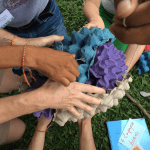The Next Financial Inclusion Revolution: The Transformative Potential of Scaling Small Group Savings in the World’s Poorest Communities
Despite $52 billion invested in financial inclusion in 2019 alone, nearly 2 billion people – many of them among the world’s poorest – still lack a bank account, a loan from a microfinance institution or a mobile wallet. This ongoing gap in formal financial access suggests that the costly effort to adapt Western concepts of banking to the poor and deliver the resulting products through electronic wizardry ignores a critical fact: The financial tools used by the poor are largely informal.
Revolving savings and credit associations (ROSCAs) – whether they’re called tontines, susus, tandas or dhikutis – are active in every town and village across emerging economies. They provide a safe place to save and access predictable and useful amounts of capital, and they keep functioning in the face of war, disease, drought and famine. Instead of algorithms and big data, ROSCAs owe their smooth functioning to long-standing traditions of savings discipline and mutual accountability. For instance, a group of 20 village women in Guatemala each contribute $2 to a common pot each week, with each in turn receiving a useful lump sum of $40. Millions of similar groups are operating across the globe.
But there are many who are too poor and marginalized to be invited to be part of a local savings circle. Below, I’ll explore a proposal that leverages ROSCAs’ advantages and builds on the good will of the leaders of these groups to reach these financially excluded individuals around the world.
The Scale of Informal Financial Institutions
Microfinance has grown to a global financial powerhouse that serves around 140 million borrowers – an impressive achievement. But, based on the World Bank’s 2017 Findex study and my own calculations, nearly four times as many people, around 510 million, save in ROSCAs. This includes the roughly 15 million members of “Savings Groups” – groups modelled on ROSCAs that are trained by NGOs and often reach an even poorer population than ROSCAs – and the 72 million members of Self-Help Groups in India, whose members are almost exclusively village women.
Savings Groups and Self-Help Groups differ from ROSCAs in that contributions are made to a group-managed fund that grows with new savings every week. Members take out loans from the fund that are repaid with interest. At the end of a year-long cycle, members receive back all their savings, plus their share of the interest – and they have access to loans whenever they need them during the year.
This approach keeps all the group’s capital – and the profits from lending – in the hands of group members, rather than funneling it to outside lenders or investors. “Why pay them, when we can pay ourselves,” group members often say.
These informal groups are not just operating in emerging economies, they are also common in the immigrant enclaves of affluent countries. But instead of saving $1 per week, they save $100 per week. This works out to $5,000 per year, and often more. Payouts represent a major source of business and housing finance. They also provide money for the remittances immigrants sent to their families back home in developing countries. Remittances totaled $540 billion in 2020 alone, three times the $161.2 billion in development assistance from all countries combined that same year. For most purposes, remittances are also much better targeted – and they come without the high costs of institutional service delivery – making them a major driver of decreasing poverty rates worldwide.
The Implications of Informal Finance for Financial Inclusion
As the above numbers illustrate, the poor are funding an important part of their financial needs through internally generated savings, providing them with a valuable pool of income within their communities in emerging countries, and generating funds for remittances from immigrants living in wealthier countries.
So, what does this imply for our work as financial inclusion advocates, funders, practitioners and researchers? I’ve argued that, since informal groups do much of the heavy lifting of enabling saving and lending in poor (and not so poor) communities, ROSCAs and Savings Groups should be considered as a key component of any financial inclusion strategy. But how can we, as outsiders, play a constructive role in supporting these informal groups? And how can we help ensure that these groups can extend their benefits to even poorer populations?
Those with an institutional finance mindset find it hard to appreciate the messy and creatively adapting reality of informal finance. We need to set aside our “bright ideas” and instead ask the leaders of ROSCAs – the experts on survival under difficult conditions – for their thoughts on how they would train and scale savings groups to serve the poorest populations who do not currently save at all. These individuals are too poor and marginalized to be served by formal institutions. They also lack access to ROSCAs and even Savings Groups, which serve those who are still poor, but who are slightly better off than many of those living in their villages.
What if the leaders of existing ROSCAs, Savings Groups and Self-Help Groups could be mobilized to train leaders of new informal groups based on their unique insights about how to reach this excluded population?
Tapping the Power of Small Group Savings
Informal finance (as is the case with any type of financial institution) is not the perfect solution. It has its share of bad actors, and some savings circles are more transparent, responsive to the community and poverty-oriented than others. We at Grassroots Finance Action suggest providing a small financial nudge to those who lead quality, poverty-oriented savings groups. This would give them an incentive to reach out to train and support new groups for those left out of formal as well as informal finance.
To that end, local organizations with deep knowledge of their communities could help with the selection, support and monitoring of these leaders. Based on an average group size of 20 members, there are roughly 750,000 savings group leaders and 25 million ROSCA leaders worldwide. There is no lack of candidates who could take on this work.
Our modest yet revolutionary proposal:
- Fund community studies to better understand the role and importance of informal finance in terms of who is part of these groups and who is left out – and in terms of its relation to institutional finance and remittances.
- As part of these studies, meet with savings group leaders to discuss and refine their strategies for financially including those who are even poorer than they are.
- Fund a three-year pilot project to test their plans and, if the results prove as positive as we expect, replicate these plans at scale more effectively and at lower cost.
Let’s say that $15 million were made available for this initiative. Based on our calculations, over three years this would result in:
- The recruitment, training and monitoring of 3,400 village-based group leaders.
- The formation of around 50,000 new savings groups with 1 million members (an average of 15 groups, trained by each leader over three years).
- The collective saving and distribution of $50,000,000 every year (an average of $1 per week per member, or $50 per year).
Research shows that over 70% of savings groups continue to operate independently almost nine years after they were trained, with no-cost peer-to-peer replication making up for disbanded groups. This answers the “sustainability” question. If these 50,000 new groups continue for 10 years, the savings they mobilize could total half a billion dollars – quite a return on a $15 million investment. Additionally, these groups would enable many people who would otherwise never be considered as creditworthy to later join formal financial institutions.
For this initiative to work, technology will play an important role. Cell phones can encourage clusters of “Community Champions” (as we call them) to meet to exchange experiences, share progress and set goals – and to discuss challenges and solutions with other Champions who speak the same language. This would build solidarity, encourage the exchange of best practices and foster a sense of shared mission. Other app-based technologies could monitor outcomes, costs and impact.
Putting Savings Groups in the Larger Context of Financial Inclusion
Each transformation in the financial inclusion field began as an experiment:
- In addition to the pioneering work of Muhammad Yunus and the Grameen Bank, a credit union in El Salvador developed the solidarity methodology in the 1950s, which was adopted by Acción International in 1980. Grameen and Acción spearheaded what became the worldwide microfinance industry.
- The Savings Group movement was started by CARE in a small cluster of villages in Niger in 1991.
- The emergence of digital finance started in the early 2000s, when Kenyans living in cities purchased phone minutes that their relatives cashed out in their home villages. Safaricom, M-pesa and the rest of the digital finance revolution leveraged what these migrants were already doing themselves.
Could building on informal financial institutions represent the next major breakthrough in financial inclusion?
With the help of donors and investors, we plan to find out. Grassroots Finance Action has a pilot project underway in Guatemala in which “Community Champions” are training a new savings group every month. If you’re interested in supporting these efforts or learning more about our work, contact us on our website or email me directly at jeffaashe@gmail.com.
Jeffrey Ashe is a Professor at Columbia University and Director of Grassroots Finance Action.
Photo courtesy of Jeffrey Ashe.
- Categories
- Finance



